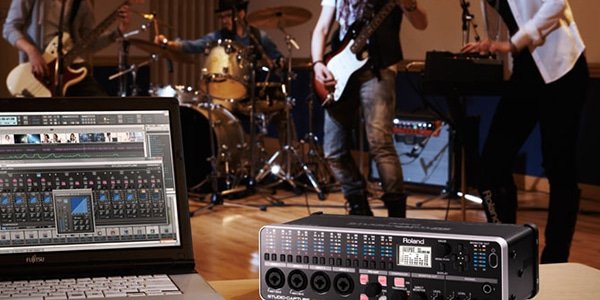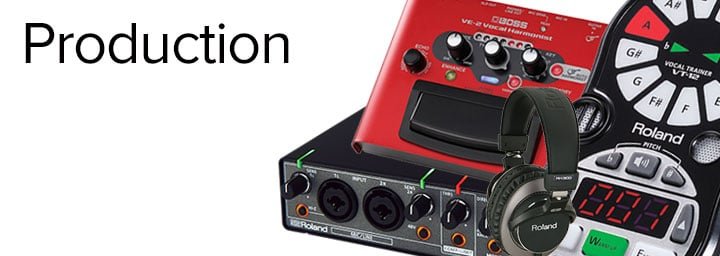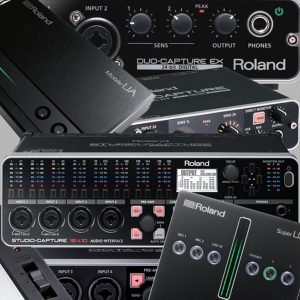The boom in DAW software means that anyone can start recording vocals at home; you just need a vocalist, a computer, a mic and a little know how. Paul White, editor-in-chief of Sound on Sound magazine shares his tricks and tips for getting it right every time.
Vocals are invariably the most important part of a mix and it’s an area where those less experienced in recording can come unstuck. You’ll find a lot of in-depth material on the subject at soundonsound.com, though it’s not difficult to make a good vocal recording as long as you follow a few simple guidelines. Indeed you can get a perfectly acceptable vocal sound using the same dynamic mic you use on stage but you’ll usually get even better results using a capacitor mic as the highs will come over more cleanly. You’ll also need a pop shield as explained a little later. The best place to start is with the recording environment itself as that has a big influence on the end result and problems encountered there can’t be fixed later.
Contributed by Roland UK
SETTING UP THE RECORDING SPACE

Too often vocals are compromised because they’ve been recorded in boxy sounding bedrooms or garages but it’s easy enough to improvise screens using heavy blankets, duvets or sleeping bags to deaden room reflections. There are also numerous commercial screens designed to go behind the mic, and these can help, but in my view the most important place to start is with the wall behind the singer as that can bounce sound back into the sensitive side of the microphone if you don’t do something about it.
Perhaps the most effective simple treatment is to hang up a couple of heavy polyester duvets in a V shape where the singer stands with their back towards the point of the V. The key point here is that you don’t need to acoustically treat the whole room, just the area around the vocalist and microphone.
If you combine the duvets with a curved commercial screen behind the mic, you can get pro vocal booth quality in a typical domestic room or rehearsal space. If the ceiling is especially low, then a square of acoustic foam fixed to the ceiling, centred between the singer and the mic, will help too.
Try to maintain a distance of between 15 and 39cm inches between the singer and the microphone where a mesh pop screen is generally placed 50mm or so in front of the mic. Pop screens are important as without them you’ll almost certainly suffer thumps on some of the plosive P and B sounds. Metal mesh types sound the most transparent, though the nylon mesh type are OK and may actually help if the singer’s voice is over-bright or sibilant as they soften the highs slightly. More up market are the reticulated foam types but a plain metal mesh works just fine.
CAPTURING A GOOD PERFORMANCE

Keeping the singer comfortable, both physically and psychologically, is also key to a good vocal performance, and that includes encouraging them to do some warm up vocal exercises before you start. Make sure that cool (but not ice cold) drinking water is on hand and if the singer is a shy type, then try to get the other band members to leave the studio when you’re recording vocal overdubs. If you need to redo something, try telling them that they can do even better, not that they’ve made a hash of it.
When working in a home studio most vocals end up being put down as overdubs as that’s usually the only way to achieve adequate separation from loud instruments such as drums and electric guitar. A guide vocal can be recorded during the recording of the main backing if required, then you can replace it later.
A good headphone mix is also important in getting the best possible performance so take the time needed to give the singer the headphone balance and volume they need. If they would like some comfort reverb in the phones, then work with them to get the right amount. If you’re working with a computer, set the buffer size as low as possible and bypass any unnecessary plug-ins so as to keep latency (headphone delay) to an absolute minimum.
The phones themselves should, ideally, be closed back types as that helps prevent sound from the headphones leaking into the microphone, and if the singer likes to work with one phone on and one phone off, make sure that the unused phone is still resting on the side of their head so as to prevent sound leakage.
Always start recording as early as possible — many pro engineers even record the warm up and sound check as the singer will feel more relaxed knowing there’s no pressure and may deliver a better performance. Even it if it isn’t complete or only some lines are good, keep them for later as you may be able to use them when you compile the final vocal. The same psychology applies when you have captured all you need but then ask the singer to belt out a final version just to see what happens. They know you have already recorded what you need, so nerves don’t get in the way.
Don’t rely on pitch correction software more than you have to. It can be used to polish a vocal that’s already pretty good but it rarely works for salvaging a bad performance. Always put pitch correction devices or plug-ins before effects such as delay, reverb or modulation as they work best on a clean signal.
Almost all pop vocals are compiled from several takes where the producer goes through each one and marks off the best and worst parts on a lyric sheet. Once all the best parts have been identified, these are compiled to form the final vocal and a modern computer recording system makes this task very easy. Don’t edit out all the breaths though as they’re an important part of the performance. You can always reduce their level if they are too obvious using mix automation.
USING VOCALS IN THE MIX
Once a satisfactory vocal part has been recorded, a suitable reverb or ambience treatment is invariably needed to add life and interest to the sound but before you do that, it’s best to take care of any level discrepancies. It can be tempting to try using only a compressor to flatten out the vocal level but a better approach is to use the level automation facility of your recording system to even out the worst peaks and dips in level before you apply compression.
COMPRESSION
High levels of compression can exaggerate any noise and sibilance present in the recording so combining level automation with compression to control your levels can lead to a noticeably cleaner result. While a gate or expander can help in cleaning up the spaces between phrases, computer users often get better results by looking at the waveform display and manually muting sections where no singing is taking place — again taking care not to mute any breath noises that contribute to the performance.
Soft-knee compressors tend to sound the most natural while fixed ratio compressors or even limiters come into their own when you need to use compression as an effect to give your vocal more of an assertive edge. For transparent gain control, start by setting the compressor so that the maximum gain reduction is just 5 or 6dBs, but for a more hard-hitting sound a gain reduction of 10dB (or slightly more) combined with a ratio of 4:1 or higher might be appropriate.
As a starting point, choose a fast or programme-dependent attack time and a release time of around half a second but always use your ears to judge the result. There’s also no shame in using a vocal plug-in preset as long as you appreciate that you will still need to adjust the threshold (or compression amount control on some models) to achieve the desired amount of gain reduction — there’s invariably some form of gain reduction meter to guide you.
EQ
No two singers have the same vocal characteristics, which is why it is usually better to try a variety of microphones to see what works best with a particular voice, but at mixing stage you’ll probably also need to use a little EQ. Excessive use of EQ can lead to a very unnatural sound so as a starting point use low-cut below 100Hz to remove unwanted lows and a shelving filter set at around 7.5kHz that you can push up by a dB or two if you need a more airy sound. Voices that are not cutting through the mix can be given a gentle and fairly wide boost at between 2 and 3kHz but
Voices that are not cutting through the mix can be given a gentle and fairly wide boost at between 2 and 3kHz but excessive boost in this region can cause harshness. If you hear boxiness in the lower mid-range then try using a gentle dip at that point to clean it up but don’t do anything too dramatic. EQ boost is always more audible than cut, so fix problems by cutting where you can.
DE-ESSING
Sibilance caused by air passing over and around the teeth during the pronunciation of S and T sounds can be annoyingly loud with some singers and gets worse as you add compression. Fortunately there are many excellent de-essers available, both as hardware and as plug-ins, where the best remove only the offending sibilant frequencies while leaving the rest of the frequency range untouched. De-ess only as much as required as processing too heavily can leave the vocals sounding ‘lispy’. Often sibilance can be reduced at source by using a nylon mesh pop filter rather than a metal mesh and/or, singing slightly to one side of (or above/below) the microphone. The choice of
De-ess only as much as required as processing too heavily can leave the vocals sounding ‘lispy’. Often sibilance can be reduced at source by using a nylon mesh pop filter rather than a metal mesh and/or, singing slightly to one side of (or above/below) the microphone. The choice of microphone can also make a big difference.
DOUBLE TRACKING
Double tracking is a popular technique for adding texture and interest to a vocal part and is routinely used on both main and backing vocal lines. Essentially, the singer performs the same part twice (or more) on separate tracks, then the tracks are played back together to give the effect of two or more singers in unison. This depends on the singer being able to replicate the same timing and phrasing on each pass, though modern DAW software provides tools that allow the occasional out-of-time word or phrase to be massaged back into line.
Where the singer can’t replicate their original phrasing, there are several ADT, or Automatic Double Tracking techniques that can be used to fake it. In the early days, a short delay of between 30 and 100ms would be added to the original vocal using a spare tape recorder and in later years the delayed version might also be detuned by a few cents using a pitch shifter.
Today there are numerous plug-ins that recreate double tracking reasonably well though my own favourite trick is to copy the vocal part, delay it slightly and then put the copy through a pitch correction plug-in or device to introduce a subtle pitch variation. When played back alongside the original, the effect is very authentic.
REVERB AND DELAY
As vocals tend to be recorded in an acoustically ‘dry’ environment, some artificial ambience usually needs to be added to make them sit comfortably with the rest of the mix. Modern digital reverbs units and plug-ins can recreate anything from very small, dry-sounding room ambiences to huge cathedrals though a plate emulation still works well for most vocals where the typical decay time might be set between one and 1.5 seconds depending on the style of music.
Today’s music tends to use less obvious reverb treatments than were common a couple of decades ago and if you listen carefully to a cross-section of pop music, you’ll often hear that a modest amount of reverb has been combined with subtle echo — or delay with a little feedback. Delays that emulate vintage tape loop echo boxes are good for this purpose and sometimes rolling off a little treble from the delay helps it sit more comfortably behind the vocal. Finding the right vocal treatment is more about art than science but always judge the result in the context of the whole mix, not in isolation.
Finally, make sure that your vocals are mixed loud enough to be clearly audible but not so loud that they sound ‘glued on’ to the rest of the mix. A great tip for judging this is to stand outside the studio door with the door left open and see how the balance sounds from there. A lot of pro engineers use this technique to double check their mix balances.
Related Articles
ARE YOU STUCK IN A VOCAL RUT?
COMPUTER MUSIC PRODUCTION FOR BEGINNERS PART 1: THE ESSENTIALS
COMPUTER MUSIC PRODUCTION FOR BEGINNERS PART 2: RECORDING AND COMPOSITION
COMPUTER MUSIC PRODUCTION FOR BEGINNERS PART 3: MIXING
THE A-Z OF RECORDING
WHICH AUDIO INTERFACE IS RIGHT FOR YOU?









